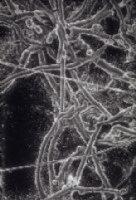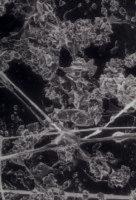

University of Minnesota
Global conversion of organic carbon to CO2 with concomitant reduction of molecular oxygen involves the combined metabolic activity of numerous microorganisms. The most abundant source of carbon is plant biomass, composed primarily of cellulose, hemicellulose, and lignin. Many microorganisms are capable of utilizing cellulose and hemicellulose as carbon and energy sources, but a much smaller group of filamentous fungi has evolved with the ability to depolymerize lignin, the most recalcitrant component of plant cell walls. Collectively known as white rot fungi, they possess the unique ability to efficiently depolymerize lignin in order to gain access to cell wall carbohydrates for carbon and energy sources. These wood-decay fungi are common inhabitants of forest litter and fallen trees. As such, white rot fungi play an important, if not pivotal, role in the carbon cycle.
White rot fungi vary in their ligninolytic selectivity. For examples, the previously sequenced lignin-degrader, Phanerochaete chrysosporium simultaneously degrades lignin and cellulose while Ceriporiopsis subvermispora rapidly depolymerizes lignin with relatively little cellulose degradation. The mechanism involved is poorly understood, although it is well established that the two species secrete different types of oxidative enzymes. Comparative analyses among lignin-degrading species will advance our understanding of these complex oxidative mechanisms involved in lignocellulose conversions.
Genome Reference(s)
Fernandez-Fueyo E, Ruiz-Dueñas FJ, Ferreira P, Floudas D, Hibbett DS, Canessa P, Larrondo LF, James TY, Seelenfreund D, Lobos S, Polanco R, Tello M, Honda Y, Watanabe T, Watanabe T, Ryu JS, Kubicek CP, Schmoll M, Gaskell J, Hammel KE, St John FJ, Vanden Wymelenberg A, Sabat G, Splinter BonDurant S, Syed K, Yadav JS, Doddapaneni H, Subramanian V, Lavín JL, Oguiza JA, Perez G, Pisabarro AG, Ramirez L, Santoyo F, Master E, Coutinho PM, Henrissat B, Lombard V, Magnuson JK, Kües U, Hori C, Igarashi K, Samejima M, Held BW, Barry KW, LaButti KM, Lapidus A, Lindquist EA, Lucas SM, Riley R, Salamov AA, Hoffmeister D, Schwenk D, Hadar Y, Yarden O, de Vries RP, Wiebenga A, Stenlid J, Eastwood D, Grigoriev IV, Berka RM, Blanchette RA, Kersten P, Martinez AT, Vicuna R, Cullen D
Comparative genomics of Ceriporiopsis subvermispora and Phanerochaete chrysosporium provide insight into selective ligninolysis.
Proc Natl Acad Sci U S A. 2012 Apr 3;109(14):5458-63. doi: 10.1073/pnas.1119912109
